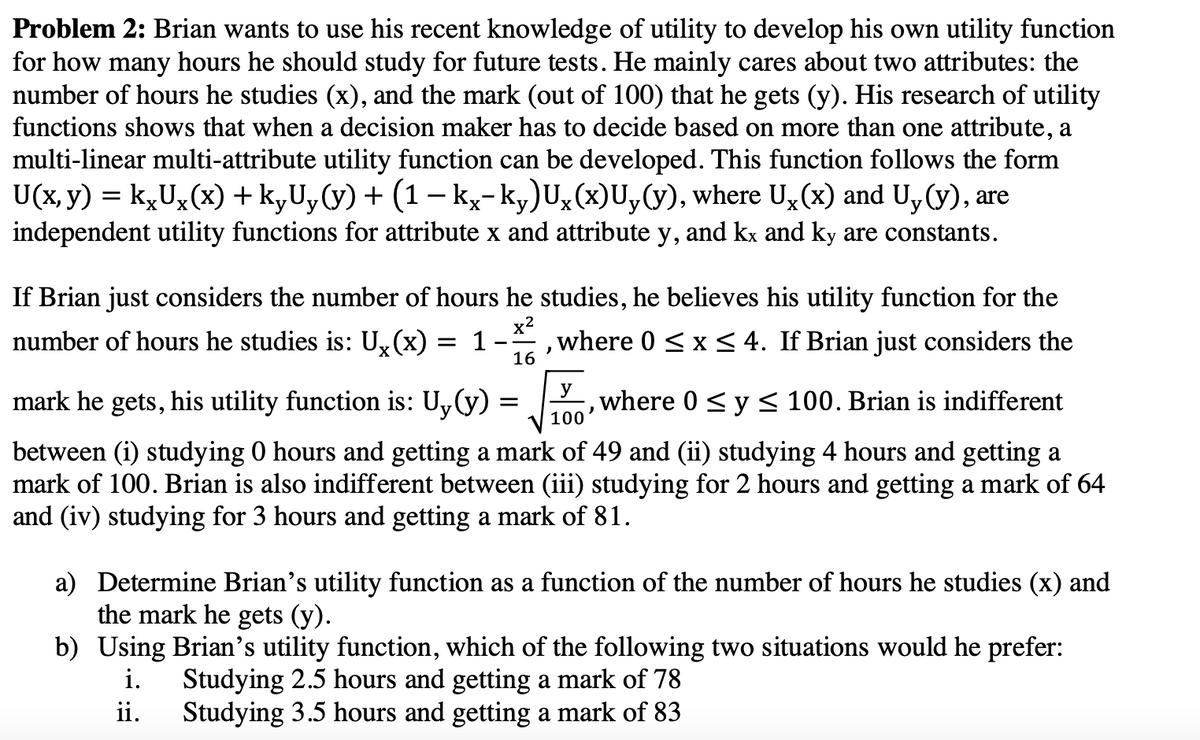Problem 2: Brian wants to use his recent knowledge of utility to develop his own utility function for how many hours he should study for future tests. He mainly cares about two attributes: the number of hours he studies (x), and the mark (out of 100) that he gets (y). His research of utility functions shows that when a decision maker has to decide based on more than one attribute, a multi-linear multi-attribute utility function can be developed. This function follows the form U(x, y) = kxUx(x) + kyUy(y) + (1 − k¸-ky)Ux(x)Uy(y), where Ux(x) and Uy(y), are independent utility functions for attribute x and attribute y, and kx and ky are constants. If Brian just considers the number of hours he studies, he believes his utility function for the x² number of hours he studies is: Ux(x): = 1-: where 0 ≤ x ≤ 4. If Brian just considers the 16 mark he gets, his utility function is: Uy(y) = where 0 ≤ y ≤ 100. Brian is indifferent between (i) studying 0 hours and getting a mark of 49 and (ii) studying 4 hours and getting a y 100'
Problem 2: Brian wants to use his recent knowledge of utility to develop his own utility function for how many hours he should study for future tests. He mainly cares about two attributes: the number of hours he studies (x), and the mark (out of 100) that he gets (y). His research of utility functions shows that when a decision maker has to decide based on more than one attribute, a multi-linear multi-attribute utility function can be developed. This function follows the form U(x, y) = kxUx(x) + kyUy(y) + (1 − k¸-ky)Ux(x)Uy(y), where Ux(x) and Uy(y), are independent utility functions for attribute x and attribute y, and kx and ky are constants. If Brian just considers the number of hours he studies, he believes his utility function for the x² number of hours he studies is: Ux(x): = 1-: where 0 ≤ x ≤ 4. If Brian just considers the 16 mark he gets, his utility function is: Uy(y) = where 0 ≤ y ≤ 100. Brian is indifferent between (i) studying 0 hours and getting a mark of 49 and (ii) studying 4 hours and getting a y 100'
Chapter4: Utility Maximization And Choice
Section: Chapter Questions
Problem 4.14P
Related questions
Question

Transcribed Image Text:Problem 2: Brian wants to use his recent knowledge of utility to develop his own utility function
for how many hours he should study for future tests. He mainly cares about two attributes: the
number of hours he studies (x), and the mark (out of 100) that he gets (y). His research of utility
functions shows that when a decision maker has to decide based on more than one attribute, a
multi-linear multi-attribute utility function can be developed. This function follows the form
U(x, y) = kxUx(x) + kyUy(y) + (1 − kx-ky)Ux(x)Uy(y), where Ux(x) and Uy(y), are
independent utility functions for attribute x and attribute y, and kx and ky are constants.
If Brian just considers the number of hours he studies, he believes his utility function for the
number of hours he studies is: Ux(x) :
= 1
x²
-
where 0 ≤ x ≤ 4. If Brian just considers the
16
=
mark he gets, his utility function is: Uy(y) :
)
y
, where 0 ≤ y ≤ 100. Brian is indifferent
J
100
between (i) studying 0 hours and getting a mark of 49 and (ii) studying 4 hours and getting a
mark of 100. Brian is also indifferent between (iii) studying for 2 hours and getting a mark of 64
and (iv) studying for 3 hours and getting a mark of 81.
a) Determine Brian's utility function as a function of the number of hours he studies (x) and
the mark he gets (y).
ii.
b) Using Brian's utility function, which of the following two situations would he prefer:
i.
Studying 2.5 hours and getting a mark of 78
Studying 3.5 hours and getting a mark of 83
Expert Solution
This question has been solved!
Explore an expertly crafted, step-by-step solution for a thorough understanding of key concepts.
Step by step
Solved in 3 steps with 2 images

Knowledge Booster
Learn more about
Need a deep-dive on the concept behind this application? Look no further. Learn more about this topic, economics and related others by exploring similar questions and additional content below.Recommended textbooks for you





